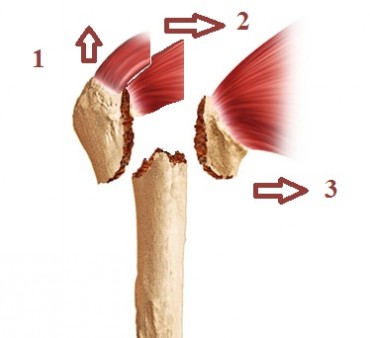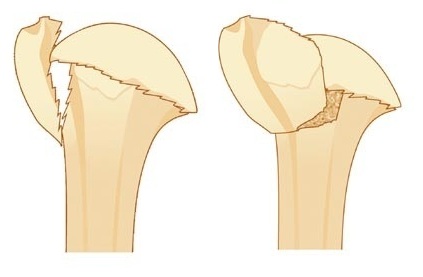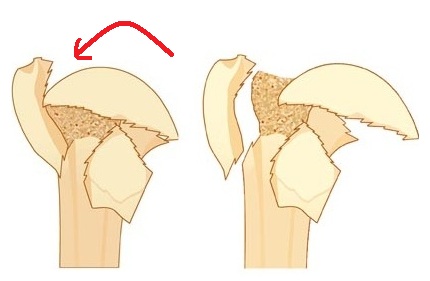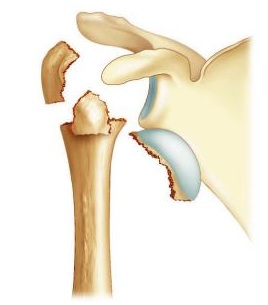Complex fractures are ultimately an association between several types of simple fractures.
The displacement of the tuberosities is related to the traction exerted notably by the mucles of the rotator cuff through their tendon insertion.
Complex fractures are ultimately an association between several types of simple fractures.
The displacement of the tuberosities is related to the traction exerted notably by the mucles of the rotator cuff through their tendon insertion.

The diagram below summarizes the different movements exerted on the fragments of complex frauds.
Fragments with 3 fragments and fractures with 4 fragments are mainly distinguished. There are also dislocation fractures where the humeral head has been expelled and is no longer related to the rest of the humerus and the articular capsule (almost certain risk of necrosis of the humeral head).
They generally associate a fracture of the cervix (surgical or anatomic) of the humerus to a fracture of one of the tuberosities (major tubercle as in the drawing on the left against, minor tubercle on the right).

We also note the possibility of displacement of the humeral head which is often impacted (head retracted into the shoulder by compression mechanism on the glenoid during the fall or trauma).
These are the most complex fracture forms, even though each fragment may have splits or sprays.
The 4 fragments are the 2 tuberosities, the diaphysis and the humeral head.

The red arrow indicates the frequent impaction in the valgus of the humeral head (horizontalization) with close contact with the rest of the fragments (so-called enmesh fracture).
The diagram on the right indicates that the head has little or no contact with the rest of the fragments, it is described as ‘unsettled’.
The risk of traumatic interruption of the vascularization of the humeral head is even greater if the angulation of the head is abnormal or the head is disengaged.
They represent the most serious cases with the greatest risk (according to age and terrain) of necrosis of the head and therefore the need for prosthetic replacement of the humeral head.

– Some fracture displacements can lead to a good functional result without operation, but the best guarantee of mobility remains an unmoved or reduced fracture.
– Reduce and fix the fragments as anatomically as possible
= ostéosynthèse(nail, pins, plates etc …)
– favor the reduction of tuberosities ++++ which constitute the main source of recovery of functional active mobilities.
– if possible keep the humeral head in the young subject leaves to reoperate to replace it in case of necrosis by a prosthesis
– Plan a shoulder prosthesis immediately for elderly or frail patients in order to better guarantee a function allowing the gestures of everyday life without underestimating the risks and complications of such an intervention …or no operation …
– long ++++ (3 to 6 months on average for single or even more than one year for complexes).
First month: most often little physio (pendular in the best case) but lymphatic drainages ++ if painful hematoma forming at the elbow (by gravity)
essential and prolonged follow-up so as not to miss a necrosis of the humeral head (well tolerated often so partial or elderly patient)